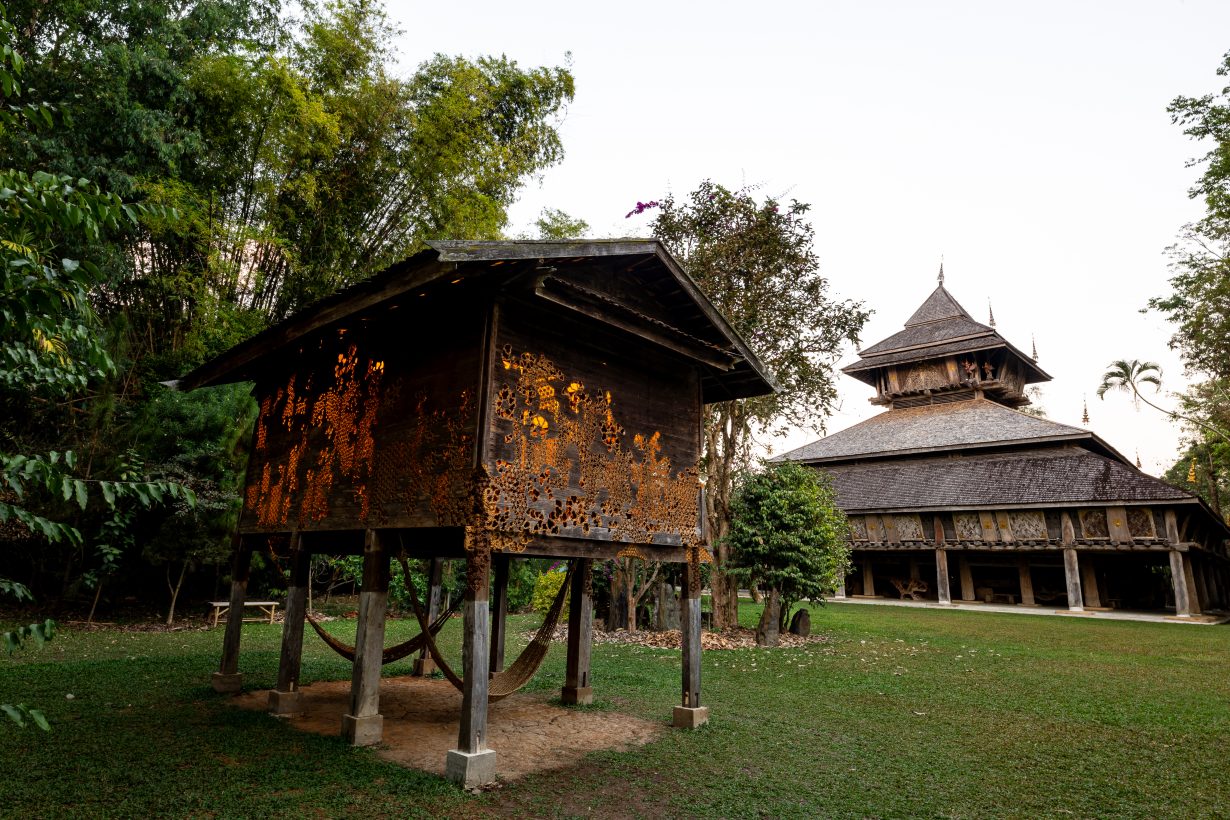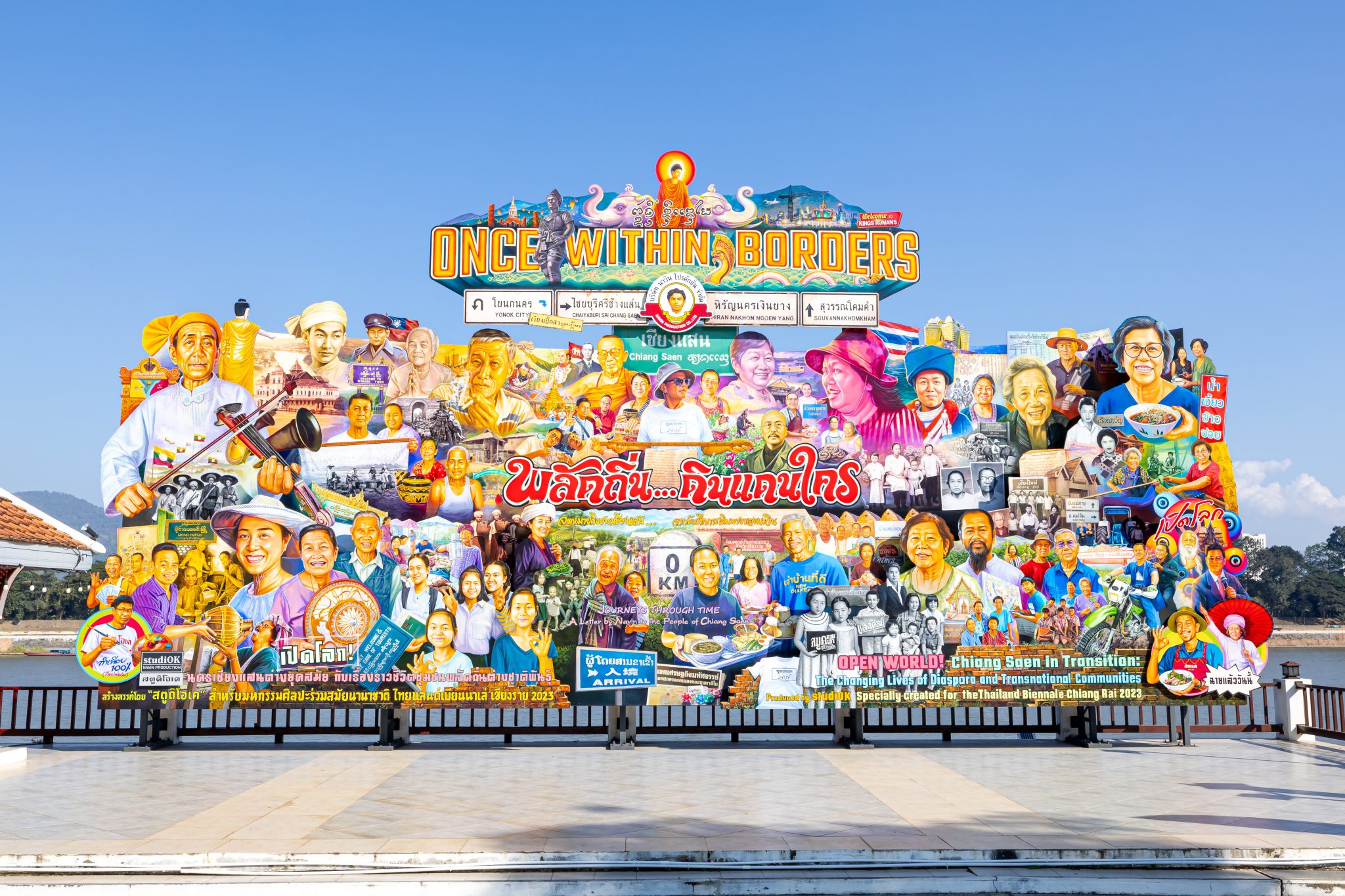The third edition, The Open World in Chiang Rai, explores how sites of social, spiritual or museological significance are meaningfully disturbed
Firsthand accounts of Chiang Rai’s rise as an ‘art city’ often point to the origins of the Haw Kham pavilion: a vaulted repository of northern Thai ‘Lanna’ objects that looms large over the lawns and lotus ponds of the Mae Fah Luang Art and Cultural Park. Raised on stilts, the pavilion itself is a bricolage of 32 salvaged wood structures, while its contents, from sattapan (an ornate candleholder) to Buddha icons, were assembled during an annual festival during the late 1980s that, according to the third Thailand Biennale’s concept statement, ‘sparked a ferment of collaboration between artists, monks, and communities, which has continued to the present day’.
Through April, the Haw Kham is also hosting a ‘live theatre’. Concealed among its treasures are makeshift versions of indigenous musical instruments, each mechanically triggered by data points being beamed from a water turbine and underwater microphone installed on a stretch of the Mekong River, near the town of Chiang Khong, about 90 kilometres north.
An inconstant yet poignant presence, the ensuing ensemble recital by unseen wooden xylophones and whining flutes more closely resembles a cardiograph reading than notes on a stave: it tracks the pace and rhythm of a contested riverscape imperiled by hydropower development and rapids-blasting projects. And yet, Nguyễn Trinh Thi’s somber sound sculpture in hallowed space, Sound-Less (Ri s̄eīyng, 2023), is also emblematic of this exhibition’s core mode of intervention: how sites of social, spiritual or museological significance are meaningfully disturbed.
The Open World, the 17 main venues and 13 pavilions of which are scattered like airborne seeds across two of Chiang Rai’s 18 districts, its provincial capital and its ancient city, doesn’t have a theme per se. Rather, it draws its stance from a Buddha posture unique to the region: standing on a lotus, arms down his sides, hands fully open, he faces out to, as the all-Thai curatorial team led by Gridthiya Gaweewong and Rirkrit Tiravanija put it, open ‘the three worlds – the heavenly world, the underworld, and the human world – so that their inhabitants could behold one another’. Roaming at the Cherntawan International Meditation Centre, I spot a literal depiction: a banner by local artist Songdej Thipthong, draped down a steeply pitched meditation hall (Open World, 2023). But a spirit of open sociability – between Chiang Rai’s diverse ethnocultural ferment and 60 artists from across the Global South – is everywhere.
On the lawn beyond the pond at Mae Fah Luang Art & Cultural Park, Ernesto Neto’s Chantdance (2023) – a biomorphic woven canopy tethered to the ground by ceramic jars – encourages gatherings and offers a space to still minds (and speaks to a Tiravanija-esque fostering of spaces and interactions in-between works). Nearby, Ryusuke Kido’s Inner Light -Chiang Rai Rice Barn- (2023) is a salvaged rice barn pock-marked with arabesques of amoebalike forms, an emblem of declining vernacular architecture and agrarian lifestyles carved with the help of local craftsmen. Elsewhere, the region’s syncretic spirit world is embraced. At the Black House, the museum-studio of late painter Thawan Duchanee, for example, works by four female artists respond to his sought-after depictions of beefy mythical beings and gothic, horn-studded architecture. Self-taught local artist Busui Ajaw’s eight gestural paintings on strung-up buffalo hide – shamanistic portals into the animist afterlife of the Akha, a nomadic tribe – are a highlight: more lived-in and disturbing than anything Duchanee produced.

Other takeaways emerge from venue hopping in this manner. For the first time in this travelling biennale’s history, the synergistic interaction and shared passion among local stakeholders is clear – to the extent that the centralised government culture ministry bank-rolling it appears to be benefiting from the host province’s largesse and expertise, rather than vice versa. From the new private Chiang Rai International Art Museum (housing 14 artworks; built by Chiang Rai’s most famous living painter, Chalermchai Kositpipat) to the glut of artist studios (62!) and collateral events, a sense of Chiang Rai putting its best foot forward is unmistakable.
With knotty debates and yelps of dissent also surfacing here and there, this edition also feels more inclusive – and feistier. Located in a former bookstore, MAIIAM Contemporary Art Museum’s Point of No Concern pavilion, for example, uses the province’s territorial peripherality as a springboard for exploring how ‘colonization and intrusions of the modern nation-state draw dividing lines between individuals’. One work is a shelf of bottled ‘shan Spirit’ liquor (‘Shan’ being one of the region’s core ethnic groups), produced by a group calling itself the Phrae Pro-Democracy Network. Some bottles have been defaced; others depict the Shan rebels who, in 1902, led a failed uprising against Siamese rule in nearby Phrae province.
Meanwhile, on a stretch of road bordering the Mekong, in the heart of the still-notorious Golden Triangle area, The Open World’s intertextual plays with the spatial and geo- political dimensions of this porous context feel at their most hard-edged. At one end, Navin Rawanchaikul & studiok’s community billboard portrait exploring legacies of cross-border trade and migration, Once Within Borders (2023), towers above the river just across from one of neighbouring Laos’s Special Economic Zones, a quasi-autonomous gambling and crime playground known as Kings Romans.
The billboard’s beaming faces and cute vignettes are lifted from an accompanying video diary, in which documentary footage of Rawanchaikul meeting minority groups is coupled with a narration that, while expressing his thoughts, alternates between their marginal dialects and voices.
In a warehouse nearby, the region’s tangled cartography and long-standing role in organised drug trafficking, among other prickly themes, are broached in works such as Nipan Oranniwesna’s Silent Traces (2023), an aerial-perspective map made from baby powder, and Ho Tzu Nyen’s woozy reimagining of opium trade archive footage in his film The Critical Dictionary of Southeast Asia: O for Opium (2022). From there it’s only a short drive to old Chiang Saen’s crumbling city walls, temple ruins and museum, where Chitti Kasemkitvatana’s Kala Ensemble (2023) – a study of Buddhism’s ancient cosmologies, centred on stone iterations of the Kala demon god and drumheads used in Lanna rituals – flanks the thirteenth-century Buddha statue that inspired this rambling event’s all-embracing posture. He looks beatific and, understandably I think, a little bit pleased with himself.
Thailand Biennale 2023: The Open World, Various venues, Chiang Rai, through 30 April
